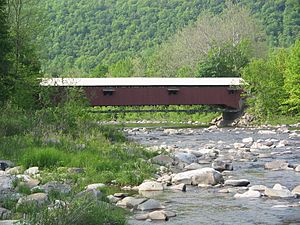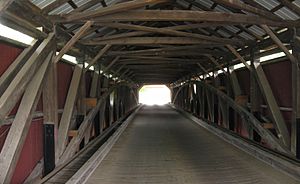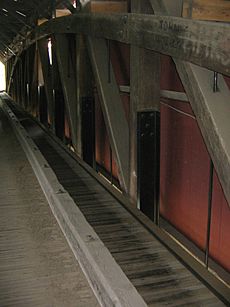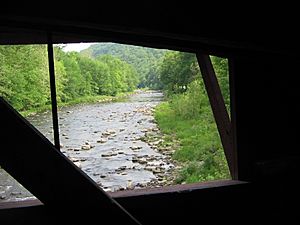Forksville Covered Bridge facts for kids
Quick facts for kids Forksville Covered Bridge |
|
|---|---|

The Forksville Covered Bridge over Loyalsock Creek, as seen from the south
|
|
| Coordinates | 41°29′18″N 76°36′00″W / 41.48833°N 76.60000°W |
| Carries | State Route 4012 |
| Crosses | Loyalsock Creek |
| Locale | Sullivan, Pennsylvania, United States |
| Official name | Forksville Covered Bridge |
| Named for | Forksville |
| Maintained by | Pennsylvania, PennDOT |
| NBI Number | 000000000032068 |
| Characteristics | |
| Design | National Register of Historic Places |
| Total length | 152.9 ft (46.6 m) |
| Width | 15.0 ft (4.6 m) |
| Height | 8.0 ft (2.4 m) |
| Load limit | 3 tons (2.7 t) |
| History | |
| Constructed by | Sadler Rogers (or Rodgers) |
| Rebuilt | 1970, 2004 |
| Statistics | |
| Daily traffic | 240 per day |
| MPS | Covered Bridges of Bradford, Sullivan and Lycoming Counties TR |
| NRHP reference No. | 80003639 |
| Added to NRHP | July 24, 1980 |
| Lua error in Module:Location_map at line 420: attempt to index field 'wikibase' (a nil value). | |
The Forksville Covered Bridge is a special old bridge in Sullivan County, Pennsylvania. It's a covered bridge, which means it has a roof and sides, like a long wooden tunnel. This bridge crosses Loyalsock Creek in the small town of Forksville.
It was built way back in 1850 and is about 153 feet (47 meters) long. The bridge is famous enough to be listed on the National Register of Historic Places since 1980. It's named after Forksville town, which got its name because it's where two creeks, the Little Loyalsock Creek and Loyalsock Creek, join together, like a "fork" in the road.
Pennsylvania was the first state in the U.S. to have a covered bridge. It also had the most covered bridges for a long time. These bridges were important because they protected the wooden parts from rain and snow, making them last much longer. The Forksville bridge uses a special design called a "Burr arch truss." This design uses a strong arch with vertical posts to make the bridge super sturdy.
An amazing fact is that an 18-year-old named Sadler Rogers oversaw the building of this bridge. He even used a small model he carved himself to guide the construction! The bridge is still used today by cars and trucks, with about 240 vehicles crossing it every day. It has been repaired and made stronger in 1970 and 2004. The U.S. Department of Transportation even uses it as an example of a classic covered bridge roof.
Contents
Where is the Forksville Bridge?
The Forksville Covered Bridge is located on Bridge Street in Forksville. This street is a small road off State Route 4012. You can find it just west of Pennsylvania Route 154. It's also about 0.2 miles (0.3 km) south of Pennsylvania Route 87. The bridge is also only 2 miles (3.2 km) north of Worlds End State Park.
Sullivan County, where the bridge is, is in north-central Pennsylvania. It's about 123 miles (198 km) northwest of Philadelphia and 195 miles (314 km) east-northeast of Pittsburgh. The bridge sits right where the Little Loyalsock and Loyalsock Creeks meet. This area was known as the "forks of the Loyalsock," which gave the nearby Forks Township its name in 1833. The town of Forksville itself was started in 1854 and became an official borough in 1880.
History of Covered Bridges
Why Covered Bridges Were Built
The very first covered bridge in the United States was built in 1800 in Philadelphia, Pennsylvania. Pennsylvania was a leader in covered bridge building. It's thought that the state once had at least 1,500 covered bridges!
In the 1800s, wood was easy to find and cheap to use for building bridges. But wood can rot quickly when it's exposed to rain, snow, and sun. So, people started adding roofs and sides to their wooden bridges. This protection helped the bridges last much longer, sometimes for over a century! Covered bridges were a step between old stone bridges and newer metal bridges made of iron or steel.
The Forksville bridge uses a "Burr arch truss" design. This means it has a strong, curved arch that works with straight vertical posts. This combination makes the bridge much stronger and more stable than if it only used one of these parts.
Building the Forksville Bridge
In 1890, Sullivan County had 30 covered bridges. But by 2011, only three were left: Forksville, Hillsgrove, and Sonestown. All three were built in 1850 and use the Burr arch truss design.
The Forksville Covered Bridge was built for Sullivan County by a young man named Sadler Rogers. He was only 18 years old at the time! Before starting the actual bridge, he carved a small model of it. He used this model to guide the workers during construction. Rogers also built the Hillsgrove bridge, which is about 5 miles (8 km) downstream on Loyalsock Creek.
The Forksville Covered Bridge was added to the National Register of Historic Places on July 24, 1980. This means it's recognized as an important historical structure. Today, the bridge is about 153 feet (47 meters) long. Its roadway is about 12 feet (3.7 meters) wide, which is only wide enough for one car at a time. The bridge has a weight limit of 3 tons (2.7 metric tons).
When you look at the bridge, you'll see small signs at each entrance that say "1850 Sadler Rogers." There's also a sign showing the height limit, which is 8 feet (2.4 meters), and a "No Trucks Allowed" sign.
The bridge sits on its original stone supports, which have been made stronger with concrete. The bridge floor is made of narrow wooden planks. There are wooden guards on the deck to keep cars in the middle and protect the walkways on the sides. The sides of the bridge are covered with vertical wooden planks. The bridge also has long, narrow windows with wooden shutters. There are four windows on the south side and three on the north side. The roof is made of metal and has a classic "gable roof" shape, like a house roof.
Bridge Repairs and Use
The Forksville Covered Bridge has survived many big floods. It stood strong during major floods in 1865 and 1889. From about 1870 to 1890, large rafts of cut lumber floated down Loyalsock Creek and passed under the bridge.
From 1908 to 1913, there was a special device on the bridge called a "stream gauge." People used it twice a day to measure how high the creek water was. The bridge also survived another big flood in 1926. However, it was badly damaged by a huge ice jam in 1959.
The bridge was repaired in 1970. A retired electrical contractor named T. Corbin Lewis did the work. The Pennsylvania Department of Transportation (PennDOT) oversaw the repairs. During this time, new steel beams were added to support the bridge's floor. A new wooden deck was installed, and the windows were cut into the sides for the first time.
In the past, some people thought about tearing down old covered bridges. But attitudes changed, and people realized how important these historic bridges are. Because the Forksville Covered Bridge is on the National Register of Historic Places, the Pennsylvania Historical and Museum Commission now protects it. They must approve any repair work to make sure it's done correctly.
The bridge was "reconstructed" again in 2004, meaning more major repairs were done. In 2006, the bridge was repainted red. In 2015, it was closed briefly for more repairs to its supports.
Even though it's old, the Forksville Covered Bridge is still used a lot. It's the quickest way to get from State Route 154 to the town of Forksville. The speed limit on the bridge is 15 miles per hour (24 km/h). In 2014, about 240 vehicles crossed it every day. The bridge is so well-known that it's even used as the logo for a local insurance company!
People love the bridge not just for its usefulness, but also for its history and beauty. One person who lived in Forksville for a long time said that when you stand quietly on the bridge, you can almost hear horses clomping over the wooden deck, just like they did long ago. Many people agree that its location "over the rocky Loyalsock Creek" is one of the most beautiful spots in Pennsylvania.
Images for kids
See also
 In Spanish: Puente cubierto de Forksville para niños
In Spanish: Puente cubierto de Forksville para niños






